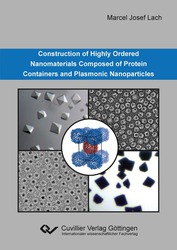| Fachbereiche | |
|---|---|
| Buchreihen (96) |
1378
|
| Nachhaltigkeit |
3
|
| Gesundheitswesen |
1
|
| Geisteswissenschaften |
2364
|
| Naturwissenschaften |
5406
|
| Mathematik | 229 |
| Informatik | 319 |
| Physik | 980 |
| Chemie | 1363 |
| Geowissenschaften | 131 |
| Humanmedizin | 243 |
| Zahn-, Mund- und Kieferheilkunde | 10 |
| Veterinärmedizin | 108 |
| Pharmazie | 147 |
| Biologie | 835 |
| Biochemie, Molekularbiologie, Gentechnologie | 121 |
| Biophysik | 25 |
| Ernährungs- und Haushaltswissenschaften | 45 |
| Land- und Agrarwissenschaften | 1004 |
| Forstwissenschaften | 201 |
| Gartenbauwissenschaft | 20 |
| Umweltforschung, Ökologie und Landespflege | 148 |
| Ingenieurwissenschaften |
1792
|
| Allgemein |
98
|
|
Leitlinien Unfallchirurgie
5. Auflage bestellen |
|
Erweiterte Suche
Construction of Highly Ordered Nanomaterials Composed of Protein Containers and Plasmonic Nanoparticles
Marcel Josef Lach (Autor)Vorschau
Leseprobe, PDF (520 KB)
Inhaltsverzeichnis, PDF (110 KB)
Nanoparticles with their unique properties are interesting building blocks for the construction of new nanomaterials. By controlling the composition as well as the structure of these nanoparticle-based materials, novel properties can emerge.
In this thesis, a new type of protein-based materials was realized by using an innovative design approach with two oppositely charged ferritin protein containers as template for the precise positioning of the nanoparticles. Nanoparticle incorporation inside the protein container cavity was performed by encapsulation of surface functionalized gold nanoparticles with a dis- and reassembly approach or synthesis of metal oxide nanoparticles in situ inside the protein container cavity. The crystallization of oppositely charged protein containers with nanoparticle cargo yielded highly ordered nanoparticle superlattices as free-standing crystals, with up to a few hundred micrometers in size. Structural studies and characterization of optical as well as catalytic properties of the binary crystals were performed. Because the protein scaffold is independent of the nanoparticle cargo, this modular approach will enable tuning of the material properties by choice of nanoparticle content, assembly type and protein container type.
| ISBN-13 (Printausgabe) | 9783736972964 |
| ISBN-13 (E-Book) | 9783736962965 |
| Buchendformat | A5 |
| Sprache | Englisch |
| Seitenanzahl | 208 |
| Umschlagkaschierung | glänzend |
| Auflage | 1 |
| Erscheinungsort | Göttingen |
| Promotionsort | Hamburg |
| Erscheinungsdatum | 27.10.2020 |
| Allgemeine Einordnung | Dissertation |
| Fachbereiche |
Chemie
Anorganische Chemie Physikalische Chemie Kristallographie |
| Schlagwörter | nanomaterial, nanoparticle, protein container, ferritin, nanoparticle superlattice, protein crystallization, self-assembly, protein crystal, optical material, catalysis, plasmonic nanoparticle, nanoparticle functionalization, surface charge, building block, supercharging, nanoparticle incorporation, disassembly, reassembly, encapsulation, batch crystallization, protein-based material, template, nanoparticle synthesis, biohybrid material, metal oxide nanoparticle, gold nanoparticle, structure diversity, modular approach, protein scaffold, oppositely charged, highly ordered, crystallization, binary crystal, material properties, cargo, dye, fluorescence, optical properties, SAXS, microscopy |
| URL zu externer Homepage | https://www.chemie.uni-hamburg.de/institute/pc/arbeitsgruppen/beck.html |








